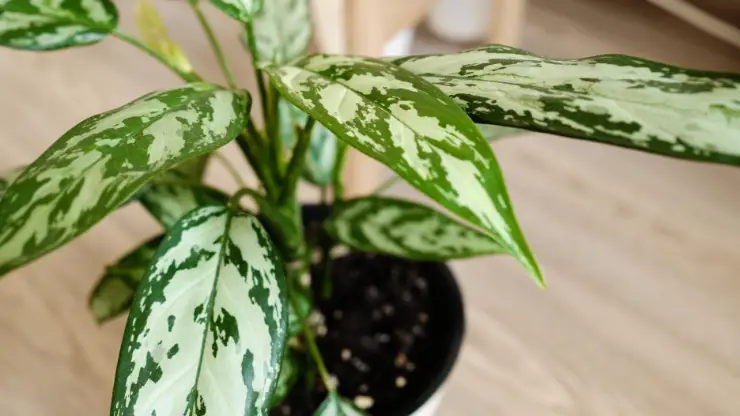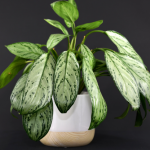If your Chinese Evergreen (Aglaonema) is struggling, don’t give up! This is one of the easiest foliage plants to grow, and it will bounce back from neglect in most cases. In this post, I’ll show you how to save a dying aglaonema.
Chinese Evergreen’s major weakness is cold temperatures, which is one of the only ways to kill this easy-to-grow houseplant. It is tolerant of low light and even under-watering. But before I can tell you how to save it, we have to figure out what your specific problem is.
Yellow Leaves
I’ve written an entire post on why Chinese evergreen leaves turn yellow (and how to fix it). But I will also briefly cover the topic here, since this is a common reason the plant may fail to thrive.
If leaves develop gray splotches that turn yellow, your aglaonema has experienced cold injury. This means temperatures have dropped too low for too long. Here’s how to save a dying aglaonema from too much sunlight:
- Remove any damaged leaves by snipping them off just at the base of the stem.
- Move the plant to a place where it won’t be chilled by cold blasts of air from doors opening, cooling vents, cold windows, etc.
- Keep temperatures above 60 degrees F (16 degrees F) at all times.
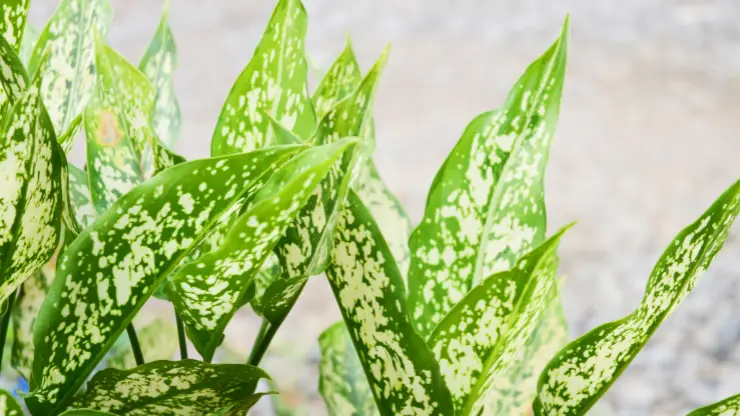
When pruning aglaonema, never remove more than 1/3 of the leaves at a time. If more than 1/3 of the leaves are yellow, remove only the worst damage. You still may be able to save the plant. Move it to a warm area and follow recommended care guidelines.
Watch for new growth, and snip off the old yellow leaves as new ones grow – a little at a time. Because new growth comes from the crown, pruning this plant back all the way will kill it. You’ll have to go slow and nurture it over time.
Root Rot or Over-Watering
If you’ve been over-watering your Chinese evergreen, it may have developed root rot. When a plant’s roots sit in excess water for too long, they begin to rot. When this happens, they cannot take up water so the plant begins to wilt and die.
Not sure if you’ve been giving your plant too much water? See my post on how to tell if your plant is overwatered or underwatered for some tips!
One surefire way you can tell if your plant has root rot is to pick up the pot and do a weight test. If the container feels heavy or has standing water inside, but the plant continues to droop and wilt like it is not getting enough moisture – you most likely have root rot.
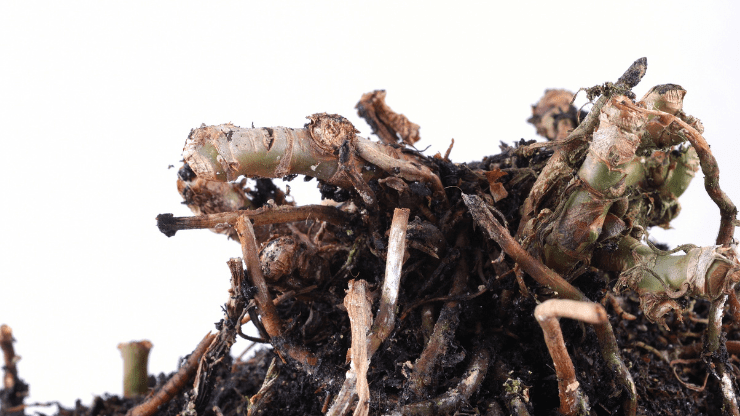
Here’s how to save a dying aglaonema from root rot:
- Place several layers of newspaper on a sheet pan or tray.
- Lay the pot on its side and gently slide the plant out – roots, soil, and all.
- Remove as much soil from around the roots as you can with your fingers. Be gentle!
- Place the plant on the newspaper, and allow the roots to dry out overnight.
- Use a clean pair of pruning shears (or sharp scissors) and trim off any mushy or dark-colored roots.
- Re-pot the plant in a clean container with fresh potting soil. Place a layer of small stones at the bottom of the pot before adding the soil to prevent standing water in the future.
Use any high quality potting soil you have on hand to re-pot your aglaonema (as long as it is formulated for houseplants). My favorite is this one by Happy Frog because it contains mycorrhizal fungi and beneficial soil microbes, but any good potting mix will work.
Too Much Sunlight
Chinese Evergreen is one of the few true low light houseplants. It absolutely cannot tolerate too much sunlight. Leaves will turn pale in color (with even paler leaf tips), and they will grow stiffly upright instead of arching attractively.

Aglaonema is native to jungle floors and needs low light to thrive. Here’s how to save a dying aglaonema plant if you suspect it’s been getting too much sunlight:
- Remove any damaged leaves by snipping them off just at the base of the stem. If leaves are just droopy, they can bounce back. Only remove severely yellowed or brown leaves.
- Move to a shadier location such as a north-facing window. An east- or west-facing window will work if the light is filtered by gauzy curtains. Never place aglaonema in a south-facing window, as this will certainly be too much light.
Scale (Insect Infestation)
Scale is the most serious insect infestation that can befall aglaonema. You’ll know you have a scale problem if your plants appear weak and slightly yellow despite watering, and you notice small disc-shaped creatures on stems and undersides of leaves.

If your plant is badly infested, it may not be possible to save it. I recommend disposing of severely infested plants (if there are more insects than you can reasonably pick off the leaves). If the infestation is light, there may still be hope.
Here’s how to save a dying aglaonema with a scale infestation:
- Isolate infested plants immediately. Move them outside, into a shed, or into a room away from your other houseplants.
- Dip a soft cloth in warm, soapy water and clean each leaf by hand, removing as many insects as possible with each swipe.
- Clean each leaf – top and bottom – and the stems. This is a laborious process, but it is the only way to save your plant from a scale infestation.
- After removing as many as possible, treat your plant with an insecticidal soap (make sure it specifies for use on houseplants).
- Place in a shady place to rest.
If you were not able to remove all the insects by wiping with the cloth, you can still continue to the next step. In most cases, the insecticidal soap will kill off any remaining scale. Then, you can wipe down the leaves and stems again to remove the dead ones.
Copper Deficiency
Another issue you might encounter with aglaonema is a copper deficiency. You can tell you have this problem if new leaves are yellow and small, and they become deformed with kinked edges.
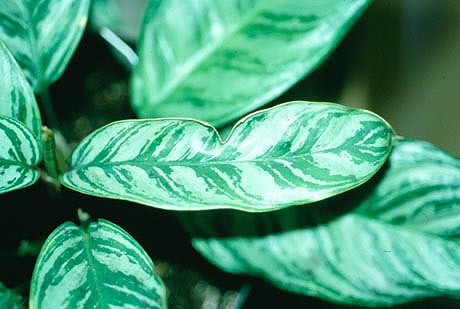
This is usually caused by low temperatures. When roots are exposed to temperatures below 65 degrees F (18 degrees C) for extended periods, this inhibits the plant’s ability to take up copper. Another cause is deficient soil or inadequate fertilizing.
Here’s how to save a dying aglaonema that’s suffering from copper deficiency:
- Treat your plant with a foliar micro-nutrient spray that includes copper as one of the nutrients. Use according to manufacturer instructions.
- Keep your plant in a warm place where temperatures are always above 65 degrees F (18 degrees C) year round.
- Feed aglaonema monthly with a balanced houseplant fertilizer during spring through summer. In winter, reduce feeding to every six weeks.
- If necessary, re-pot your Chinese evergreen with fresh potting soil. In some cases, the soil may just be spent. It’s a good idea to re-pot this plant every two years to refresh the soil.
Nutrient deficiency can happen if your plant has not been re-potted for many years, was planted in poor quality soil, or has not been adequately fertilized. It will benefit from using a plant food that replenishes its micro-nutrient supply.
My favorite houseplant fertilizer is Jack’s All-Purpose Fertilizer, but any all-purpose food will work. Read my review of Jack’s Fertilizer to see why I love it so much. I use it on almost all my houseplants.
How to Save a Dying Aglaonema
In most circumstances, Chinese Evergreen is a hardy houseplant that can be saved from neglect, over-watering, too much sunlight, inadequate feeding, and even insects. Here’s a summary of how to save a dying aglaonema:
- Remove damaged leaves (but not more than 1/3 of the total foliage).
- Move the plant to a warm location in a north-facing window or that receives low, indirect light all day.
- Keep temperatures above 65 degrees F (18 degrees C) at all times.
- Use the instructions above to save a dying aglaonema with root rot.
- Re-pot in fresh soil, remove scale insects using an insecticidal soap, treat with a micronutrient spray if necessary, and feed regularly with a balanced houseplant fertilizer.
Your aglaonema plant will be thriving again in no time!
The only time it might be too late to save your plant is if ALL the foliage has died or turned brown, or if there is a severe insect infestation. Most other problems are easy to fix. There’s a reason Chinese Evergreen is one of the most popular houseplants.

